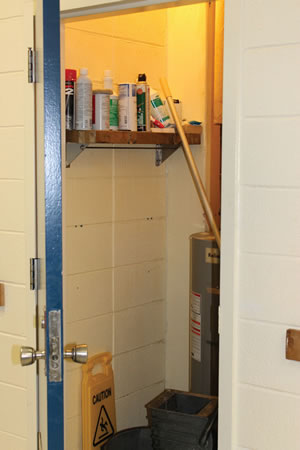Preventing Sexual Assault, Grooming and Child Molestation in Schools
- By Michael S. Dorn
- 06/01/17

PHOTO COURTESY OF SAFE HAVENS INTERNATIONAL
While school shootings may dominate media coverage and internet chatter, school officials must be sure not to ignore other, far more common, types of crisis events. For example, non-custodial abduction of students is a significant problem with some cases resulting in students being taken to other countries, and in rare instances, even murdered after they are abducted from schools. Sexual assaults and molestation of students are among the more common and traumatic types of school crisis events.
Sexual violence takes place in elementary, middle and high schools. These types of incidents have taken place in public school districts of every size, charter schools, faith-based schools and in some of the nation’s most prestigious independent schools. Sadly, sexual predators work diligently to seek access to youthful victims by obtaining employment, volunteering and defeating weak access control approaches in schools. And in an often overlooked point, sexual predators who use physical force or persuasion to victimize children are often students themselves. As schools are entrusted with the care of vulnerable populations, they have legal and moral obligations to take reasonable steps to prevent, detect and respond to sexual victimization of students and staff.
There are a wide array of opportunities to prevent sexual violence in schools that have little to do with physical security technologies and school design. For example, robust employee screening, training for staff on boundary invasion, grooming behaviors and sexual misconduct can help school officials deter and detect sexual predators. Thoughtful and structured student supervision is one of the most effective and often inexpensive ways to prevent sexual assaults by intruders and student perpetrators.
For organizations that desire truly high-end prevention efforts, there are validated screening tests that can identify adults who are at higher risk to molest students. While these types of approaches are valuable options for an effective prevention, detection and response strategy, there are also a variety of technology options and building design concepts that can help support them.
Natural surveillance
Natural surveillance is one of the three core philosophies of crime prevention through environmental design (CPTED). CPTED is a research-based approach to reduce crime and the fear of crime in buildings and outdoor spaces. Human supervision of students, staff and physical space are among the most powerful concepts to prevent sexual violence on K-12 campuses. The rapist and the child molester alike typically seek privacy with victims. Well-intentioned active shooter training programs are causing significant problems with teachers and other staff covering their classroom and office windows because of fears that a gunman will be able to see inside the classroom. Blocking windows in this manner can create a strong argument for attorneys to demonstrate a failure to meet the standard of care for security because the practice creates privacy for predators to groom victims. More importantly, this practice makes it easier for the sexual predator who obtains employment with a school to blend in because other staff who are not sexual predators are allowed to block vision panels.

PHOTO © MICHAEL DORN/SAFE HAVENS INTERNATIONAL
The use of murals, artwork and bright color schemes can not only help to increase the sense of ownership and connectivity, but can also help to prevent a prison-like environment. This beautiful photo-mural helps to create a warm and welcoming tone in this New Delhi international school where good physical security is evident but not overwhelming.
Building designs providing improved visibility can reduce the number of hidden areas that can be used by an attacker to rape or molest a victim. Reducing the number of hidden areas can reduce the burden of school security, school-based law enforcement officers, administrators and other staff to maintain effective supervision of students. For example, in many cases, simply adding a window to an office can create natural surveillance for an otherwise hidden hallway.
Natural access control
While electronic access control systems supported by effective training and practices can further enhance the security of schools, building designs that create natural access control are also of considerable value. Another aspect of CPTED, the concept of natural access control involves building designs which naturally channel people past locations that are staffed by a “capable guardian” such as a school office employee. This approach makes it more difficult for a person who is not authorized to enter an area without being observed. Though the concept has been in use for more than 40 years, many new school designs still lack this valuable feature. School renovation projects can offer excellent opportunities to improve natural surveillance.
Positive territoriality
The third core element of CPTED involves efforts to create a sense of connection and ownership between legitimate users and physical places like schools. This is known as positive territoriality. Murals, color schemes, artwork and other physical features can result in an increased tendency for students to get involved in their own safety. For example, excellent use of positive territoriality can make students more comfortable in reporting sexual harassment, sexual assault, sexual misconduct by staff or a suspicious person. Effective use of positive territoriality can also help to tone down the feel of physical security measures like security cameras, remote buzzer access and visitor management systems. When school officials increase the implementation of physical security measures, increasing the use of murals, colorful flooring, bright paint schemes and the use of artwork can help prevent a prison-like environment while helping to enhance school climate.
Access control
There are two types of access control that can help to prevent sexual assaults. We most commonly think of perimeter access control prevent campus violence. Good perimeter access control is one opportunity to prevent sexual assaults and sexual molestation of school children. There have been enough instances of intruders entering schools and committing acts of sexual violence to demonstrate that this can be one good reason to consider locking exterior doors during the school day, using remote electronic access systems and robust visitor management systems. However, interior access control can be just as important. Unlocked closets, mechanical rooms, classrooms, auditoriums and other areas have been used by intruders who defeat perimeter security measures and by students to perpetrate acts of sexual violence in schools. As untrained school employees may not inherently know that it can be dangerous to leave these types of areas unlocked, it is a good idea to make staff aware of these hazards through written policies, staff development and proper building leadership.
Visitor management systems
Paper student contact cards that were the norm in schools for decades. Today’s school officials have a variety of superb options for electronic visitor management systems that can be used to rapidly screen visitors, vendors and volunteers for child custody orders, matches on sexual predator databases, and for an extra fee, limited criminal history information. When the cost and benefits of these systems are considered, electronic visitor management systems can be an excellent investment.
Smart cameras
My clients know that I am probably the one of the last guys in the field to assume that security cameras are an automatic fix for school safety. However, the features of security cameras have improved dramatically over the past decade. Today’s smart cameras paired with robust software can incorporate astounding features such as gunshot detection, fire detection, audio analytics and much more reliable video analytics. While I have traditionally found security cameras to be far more helpful in determining what did and did not happen after a complaint was received, smart cameras can help prevent sexual assaults in some potential problem areas. For example, sexual assaults in stairwells and hidden alcoves in stairwells are a significant concern in schools. I was consulted on a particularly tragic case where a 10-year-old boy raped an 11-year-old boy in a stairwell of a charter school. This incident resulted in permanent closure of the school. In the past, I have suggested open stairwell designs, magnetic door hold-backs and parabolic mirrors to reduce privacy in these types of areas. While these are still among the most effective preventive measures, smart cameras with software to detect the sounds of aggression and video analytics software that can detect people who loiter in stairwells and trigger an alarm to alert staff to check the camera view.
While security technologies and building design alone should not be relied on to protect students and staff from sexual violence, they can dramatically enhance other important approaches to reduce the risks of these painful and damaging crimes of violence in schools.
This article originally appeared in the issue of .